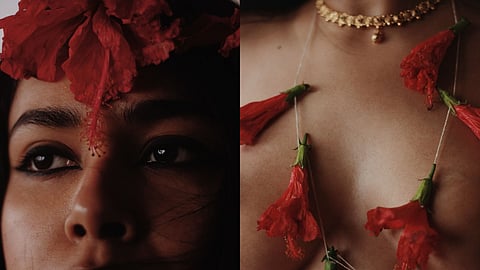
- HOMEGROWN WORLD
- #HGCREATORS
- #HGEXPLORE
- #HGVOICES
- #HGSHOP
- CAREERS
- ABOUT US
- CONTACT US

Growing up, the hibiscus or chembarathi that grew in abundance around Kerala wasn’t just a beautiful flower. It was a staple at temples and an indispensable part of flower carpets made for Onam. Pop-culturally speaking, ‘wearing a chembarathi’ was the mark of a crazy person in Kerala. But if you travel to Hawaii, the same act of wearing Hibiscus behind the ear is the sign of a woman in a relationship.
But for most Indians, Hibiscus is often associated with the goddess Kali and her fiery, passionate anger. For those who worship her, it is used as a marker of passion, a plea for protection, and a reverent offering to her divine power. No matter what memory you associate with it, chances are that if you’ve lived in India, the Hibiscus is something that you’ve grown up seeing. But the hibiscus and most flowers really, are just like the human body; it can mean different things based on our perception, culture, and influences.
For Ishani Das, a Mumbai-based cinematographer, and director within the lifestyle and fashion sector. Her personal projects and experimentation with portraiture are something that she shares through her Instagram. On the occasion of celebrating two years of Hoovu Finds, a community for flower lovers, Ishani did a takeover of their page and in conjunction, released her latest self-portrait series captioned ‘Kali and her fiery red joba phool’. As someone with widely different associations with the flower, it was fascinating to see the sensuality and fierceness that the artist brought to the frames, which highlighted the Hibiscus through her unique perspective.
Over a quick chat, Ishani talked about how the Hibiscus reminds her of her home and her mother. Barely 8 months into her move, she admits to often feeling adrift between the heritage city of Delhi that she grew up in, and the teeming city of Mumbai that she is trying to build a home in. But the very feeling of not belonging, she confessed, made her yearn to find something that was deeply rooted.
In her venture to find that illusive something, she started to seek out a red hibiscus plant for her house in Bombay. But she soon realised that the hibiscus that she loved growing up, is one that requires far more sun and space than she can offer to it. This was something that annoyed her because she had spent a lifetime seeing her mother pluck the red hibiscus flowers from their garden in Delhi and was something that was intertwined with her idea of home; something she wanted in her new place as well.
But when prompted to think of her idea of home, she mentioned how more than her specific memories, the fiercness of the red Joba Phool (Hibiscus in Bengali) is what truly reminds her of her mother. She mentioned, “My mother is probably the sweetest person you would have come across, but the woman has Kali inside of her too. My mother won’t accept it but that red tongue does come out, with her foot stomping on the banalities of the society and the Laal Joba Phool that she plucked in the morning turning into a garland around her neck.”
Through her photoseries, Ishani mentioned she channelled her inner Kali but at her most calm and even naive disposition, while still being fierce. And though she may not be able to grow the Laal Joba Phool that she knows and loves, Ishani concluded our chat on her photoseries with a thought that lingered:
“So what if I can’t grow the flowers in my house? I can sometimes wear them around my neck (invisible most times, like all women do).”
Ishani Das, Cinematographer and Self-Portrait Artist
You can follow Ishani Das here.
If you enjoyed reading this, here's more from Homegrown:
Kanakavalli’s Latest Editorial Captures The Beauty Of Ageing & The Passage Of Time
Divya Balakrishnan’s Editorial Powerfully Contrasts South Indian Tradition and Modernity
Spurthi Gowda's Latest Collection Is An Ode To The Resilient Spirit Of The Sunflower
